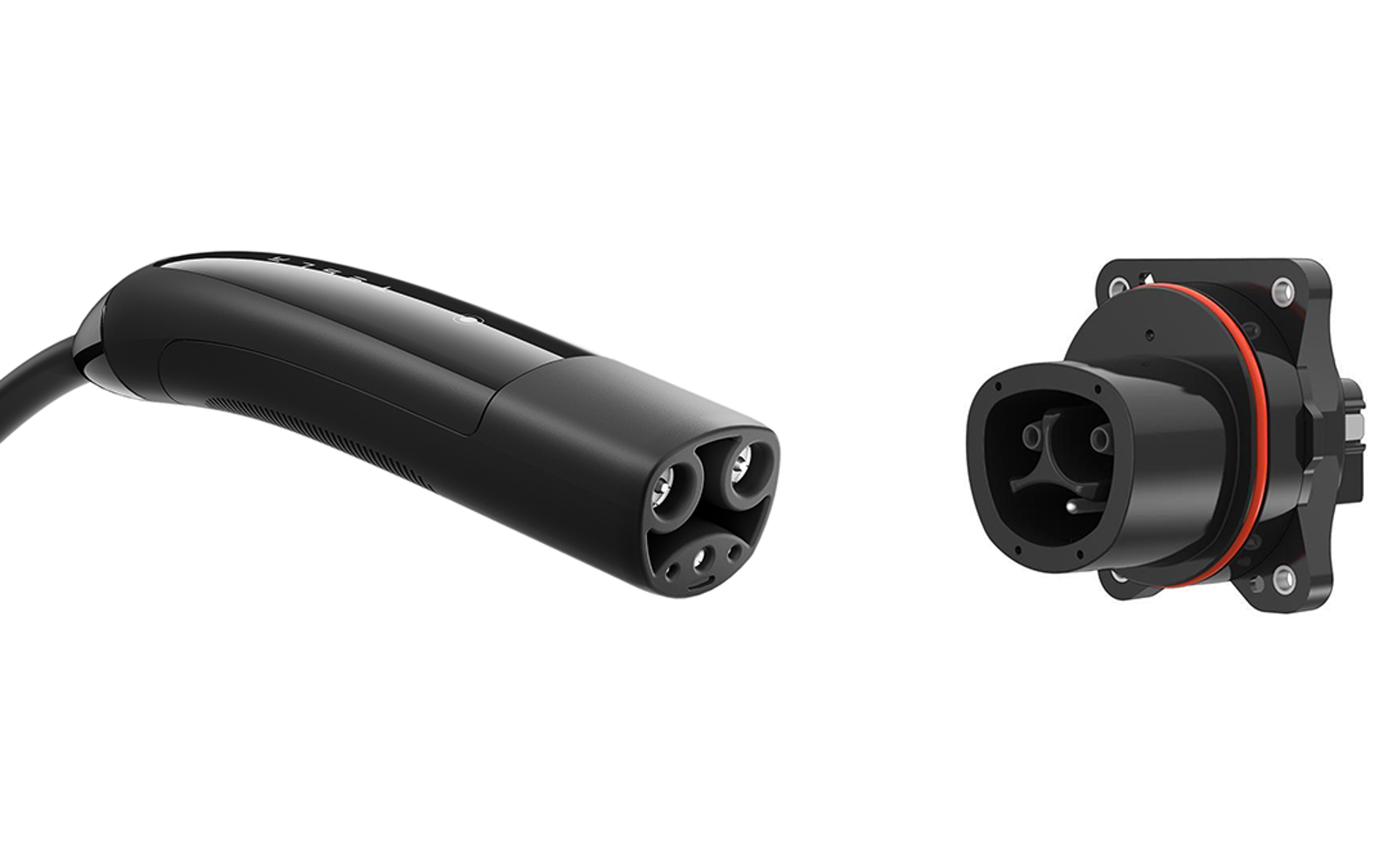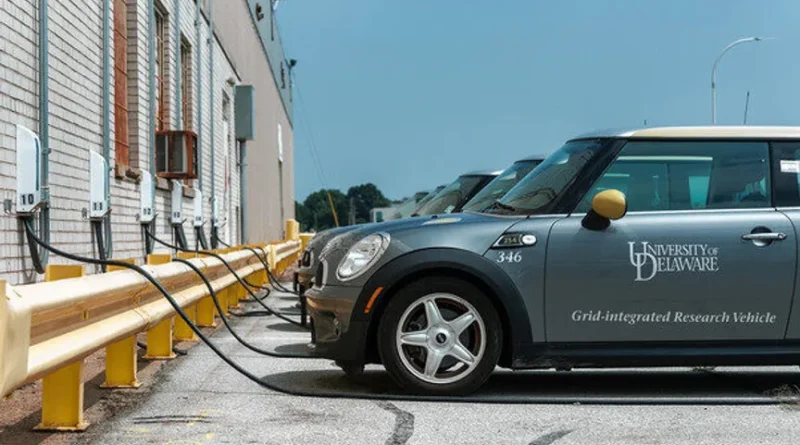SAE Adopts New Standards For Vehicle-To-Grid
There is a delightful fantasy out there that says the batteries in all the electric cars in the world could act as a giant, distributed virtual power plant that would store electricity from renewables when it is abundant and supply it back to the grid when demand exceeds supply. The batteries could also perform grid stabilization chores. Thanks to V2G, short for vehicle-to-grid, utilities would save a bundle by not having to buy grid-scale storage batteries of their own and would pay EV owners for the privilege of using their batteries instead.
This dream is certainly appealing, but making it a reality requires a lot of things to happen all at once. University of Delaware professor Willett Kempton and his team of EV researchers first started using electric vehicles as grid batteries in 2007. Their first of its kind experiment has since been replicated in V2G projects around the world.
Kempton knows there are technology and policy gaps that are holding V2G back from being widely adopted, which is why he has spent years working on a technology standard that could make V2G a realistic option for automakers, utilities, and drivers alike. The standard is called SAE J3068. In January, SAE International formally adopted key new V2G capabilities that Kempton calls them a “practical, low cost and implementable” way to turn every EV into a roaming grid battery.
Why V2G Standards Matter
The big challenge, Kempton tells Canary Media, is providing utilities with all of the data points they need in order to feel comfortable receiving power from EVs. “When something is pushing power onto the grid, they want to know what that is,” Kempton said. “They don’t want to be like, ‘We’re 95 percent sure which car it is.’”
Today, the charging technologies in use in EVs and charging stations just aren’t set up to provide and manage that information, Kempton said. V2G is particularly complicated when it’s the EV itself, rather than the charging station it is plugged into, that needs to communicate with the utility. Level 1 and Level 2 chargers that operate on AC are not equipped to send utilities the data needed for V2G to work.
DC fast charging systems, on the other hand, contain inverters that convert AC grid power to direct current. These inverters manage the interplay of the grid with the charger and vehicle. But with Level 1 and Level 2 charging, “the inverter is in your car,” Kempton says. That makes every V2G-capable EV “a roaming inverter,” which makes it more complicated for utilities. Now they need to certify an inverter that moves from place to place instead of one that’s permanently connected to the same point of the grid.
Most EV drivers will use DC fast chargers to quickly charge up and go, making it unlikely their cars will be available for V2G charging. AC charging, which takes place at home, at work, at shopping centers, and other places where people leave their cars plugged in for hours, is a much more suitable setting for V2G for the mass market.
The SAE J1772 technology standard used for Level 1 and Level 2 AC charging is simply not capable of telling utilities everything they need to know. It “can say three or four things,” including whether it’s “connected to a charging station” and whether it’s “ready to charge,” Kempton says. It can also limit how much power an EV draws from the charging station. “That’s the whole repertoire of signals. That’s great if you want to plug in and charge — but not for much else.”
EVs that adopt the new standards will be able to manage “about 200 signals.” What’s more, instead of using the simple analog communications system used in the previous iteration, the new standard adopts technology that uses digital communications that can be carried via an existing wire in the power charging cord itself or via wireless signals, which makes it far more useful for communicating all kinds of things that most of today’s chargers can’t.
V2G For Level 1 & Level 2 Charging
For example, EVs using the old standard can’t send the various diagnostic codes and error signals that charging stations rely on to troubleshoot charging glitches that can cause charging errors — a gap that’s partly responsible for the problematic performance of many public EV chargers today.
Last year, SAE adopted another update to the standard, J3068/1, that includes the diagnostic and identifying capabilities that EV drivers, automakers, and charging station operators can tap into to better troubleshoot charging problems. It can also identify the car or account to the charging station, enabling payment without always swiping a credit card.
But what really excites Kempton is another SAE standard — J3068/2 — adopted last month which enables V2G capability for Level 1 and Level 2 charging. J3068/2 makes it possible to provide “electrical certification” of individual vehicles by recognizing each EV via a unique digital identifier that utilities can reference to check whether they are authorized to supply power to the grid.
The same certification system also enables the utility to communicate “grid codes” with EVs to stop discharging power if local grid circuits are overloaded, for example, or to request that it supply power to mitigate grid disruptions. Finally, it allows utilities to pay EV owners for volunteering their battery capacity via a V2G system.
“In the case of DC [chargers], your inverter is bolted to the ground,” said Hamza Lemsaddek, vice president of technology at Nuvve, a V2G company that was spun out of Kempton’s work at the University of Delaware. Nuvve is coordinating moneymaking V2G projects in several European countries and in Japan, as well as in Delaware and California, all of which use charging stations as the control center rather than EVs themselves. “When you move to AC V2G, you have a roaming inverter, and you have to ensure that wherever it connects, it has the proper settings as required by the local utility to inject power,” he said.
 Chip in a few dollars a month to help support independent cleantech coverage that helps to accelerate the cleantech revolution!
Chip in a few dollars a month to help support independent cleantech coverage that helps to accelerate the cleantech revolution!
DC Vs. AC
DC fast chargers use a standard called ISO 15118-20 to manage vehicle-to-grid communications and operations. That standard is “great for DC V2G, but it is missing some key signals and functionalities for AC V2G,” he said. Utility pilot programs have concentrated on vehicle-to-home applications, which avoid the complications of feeding power stored in EVs back to the grid, or they have relied on less well-suited standards and one-off technology workarounds to test true V2G.
Kempton says he hopes automakers will soon start building these new capabilities into their EVs and that utilities will invest in the communications and control systems needed to work with them. If the technology takes off, it could help millions of EV owners use their batteries to earn extra money and provide a significant boost to an increasingly stressed power grid.
As a first step, his team at the University of Delaware’s Science, Technology and Advanced Research Campus plans to start a pilot project next month with Delaware-based utility Delmarva Power, one of six regulated utilities owned by Chicago-based Exelon. That pilot will test the newly standardized capabilities on a handful of utility-owned vehicles.
A 2021 study by University of California – Irvine professor Brian Tarroja and Rochester Institute of Technology professor Eric Hittinger found that V2G could make a big difference for California’s grid. They calculated that the combined value of the energy storage capacity of V2G enabled EVs in California is “approximately an order of magnitude larger than that for smart charging.”
NACS Is Simpler And Cheaper

Tesla’s North American Charging System (NACS) standard was certified by SAE for use by other charging manufacturers two months ago. That standard, known as J3400, supports a different communications technology that’s simpler and cheaper to implement than CCS technology and can be easily adapted to work with J3068/2. That “opens the door for massive adoption of that technology standard, Lemsaddek said.
EV charger manufacturers are also gearing up to enable AC V2G capabilities in their chargers, said Eduard Castañeda, chief innovation officer at Spanish-based charger manufacturer Wallbox. “We anticipate this standard will accelerate AC bidirectional charging in the U.S. and likely enable it ahead of even Europe,” which is generally more advanced than the U.S. on EV charging.
Kempton emphasized the importance of getting utilities and automakers on the same page on V2G. “There are some significant [automakers] planning to put J3068 technology and sensing” into upcoming EV models, he said. “That’s an implementation decision that requires forward looking engineering” but adds very little cost in exchange for much greater AC charging functionality and reliability.
Utilities also need to establish the interconnection processes for V2G capable EVs and payment programs that make it worthwhile for EV owners to sign up, Kempton said. At that point, the path for his two decades of V2G work to come to fruition is relatively clear, he added — “You just need to have enough EVs to make it happen.”
Have a tip for CleanTechnica? Want to advertise? Want to suggest a guest for our CleanTech Talk podcast? Contact us here.
Latest CleanTechnica.TV Video

CleanTechnica uses affiliate links. See our policy here.

